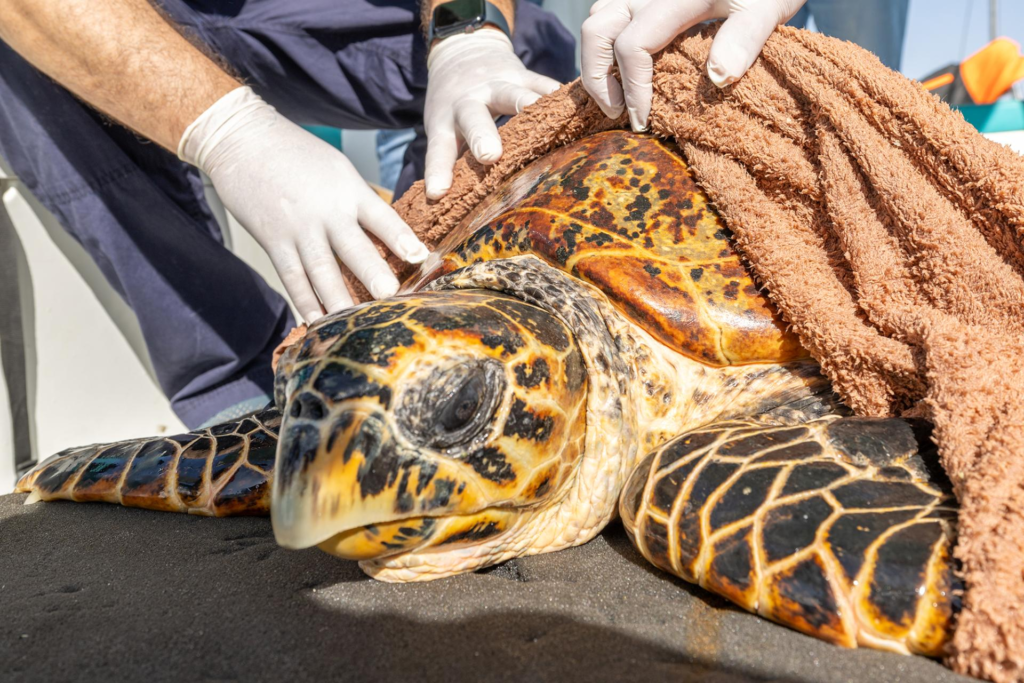A Turtle’s Triumph: Eidah’s Journey Back to The Red Sea

A heartwarming story of resilience and recovery unfolded in the tranquil waters of Al Wajh Lagoon during Eid al-Fitr. A boat captain from Red Sea Global’s (RSG) Environmental Operations and Marine Enhancement team spotted a Hawksbill turtle in distress and unable to dive—a critical survival skill for sea turtles.
The captain immediately called for help and ‘Eidah’ was transported to the expert care of the Environmental Protection and Rehabilitation (EPR) Department in Turtle Bay. Here, experts discovered she was suffering from severe buoyancy issues, likely due to an accumulation of gases inside her digestive system. The team then transported Eidah to the Fakieh Aquarium in Jeddah for further tests.
The Path to Recovery
A detailed examination revealed Eidah was suffering from floating syndrome, a potentially life-threatening condition for turtles. The rehabilitation process involved sophisticated echosonograms – graphic displays obtained with ultrasound pulse-reflection techniques – and blood tests to assess her internal state.
A carefully managed treatment plan, including dietary adjustments and medication to alleviate her symptoms, facilitated a slow yet steady recovery. After addressing her initial symptoms, Eidah’s body condition improved significantly as she began to eat well, with squid emerging as her favorite item on the menu.
Over several weeks of meticulous care, Eidah regained her ability to dive and maintain buoyancy, signaling her readiness to return to her natural habitat.
The Science Behind the Rescue
The EPR team, in collaboration with the Fakieh Aquarium, utilized the echosonograms and comprehensive blood samples to better understand floating syndrome. While the syndrome itself is not lethal in every case, the positive buoyancy exposes turtles to other risks, such as boat strikes and predators, as they are unable to swim properly.
The condition is still not fully understood by scientists but has been observed in several turtles in the region. Eidah is the sixth turtle RSG has rescued with this condition. Our ongoing research is crucial for developing more effective conservation strategies and interventions for marine wildlife afflicted by similar conditions.
The day of Eidah’s release back into The Red Sea was a testament to the efforts of the entire RSG team involved in her rescue and rehabilitation. Equipped with titanium flipper tags, Eidah’s progress will continue to be monitored, contributing valuable data to our research on marine turtle health and migration patterns.
Why Every Turtle Counts
The conservation of species like the hawksbill turtle is vital for the biodiversity of our oceans. Each rescue not only saves an individual animal but also contributes to the broader effort of maintaining healthy, thriving marine ecosystems.
At RSG, we are deeply committed to our role as stewards of the environment, ensuring that the beauty and diversity of The Red Sea are preserved for generations to come. Our waters host important populations, which in some cases are the biggest populations within the entire Red Sea. For example, Waqqadi and Breem Islands are key sites for Hawksbills and Green turtles, respectively.
Looking Ahead
With the upcoming completion of the new EPR turtle recovery center at Turtle Bay, RSG reaffirms its dedication to expanding its conservation capabilities. This state-of-the-art facility will not only enhance our ability to rehabilitate and provide first aid attention for critical cases of marine animals, but also serve as a hub for research and education, furthering our commitment to regenerative tourism and environmental stewardship.
Eidah’s story is a powerful reminder of the impact of dedicated conservation efforts and the hope that each successful rehabilitation brings to the future of our planet’s marine life. Join us in celebrating her return to the wild and the continued success of our environmental initiatives at The Red Sea destination.





 Email: info@cyber-gear.com
Email: info@cyber-gear.com